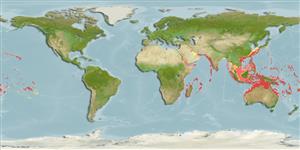Preferred temperature (Ref.
123201): 23.4 - 28.8, mean 27.4 °C (based on 1536 cells).
Phylogenetic diversity index (Ref.
82804): PD
50 = 0.5000 [Uniqueness, from 0.5 = low to 2.0 = high].
Bayesian length-weight: a=0.02399 (0.01806 - 0.03186), b=2.94 (2.86 - 3.02), in cm total length, based on LWR estimates for this species (Ref.
93245).
Nível Trófico (Ref.
69278): 2.2 ±0.11 se; based on food items.
Resiliência (Ref.
120179): Muito baixo, tempo mínimo de duplicação da população maior que 14 anos (K=0.14; tmax=54.5).
Prior r = 0.28, 95% CL = 0.18 - 0.42, Based on 3 data-limited stock assessments.
Fishing Vulnerability (Ref.
59153): Low to moderate vulnerability (32 of 100).
🛈
Climate Vulnerability (Ref.
125649): Very high vulnerability (80 of 100).
🛈
Nutrients (Ref.
124155): Calcium = 33.3 [16.8, 58.2] mg/100g; Iron = 0.554 [0.285, 1.039] mg/100g; Protein = 18.4 [17.1, 19.7] %; Omega3 = 0.109 [0.065, 0.196] g/100g; Selenium = 58.8 [29.8, 118.5] μg/100g; VitaminA = 21.5 [5.0, 90.1] μg/100g; Zinc = 1.03 [0.66, 1.54] mg/100g (wet weight);
